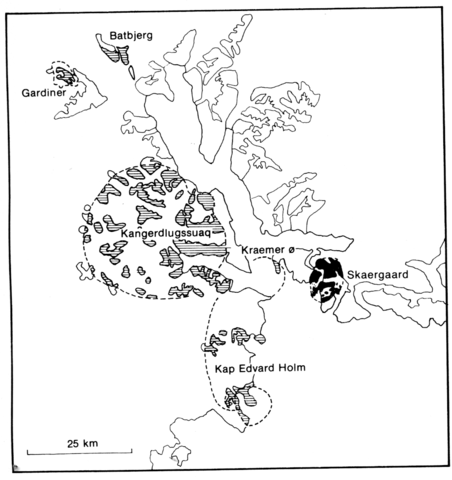stripes
More than half of the Kap Edvard Holm complex is ice covered, and of the exposed rocks a high proportion are cumulate gabbros, references to descriptions of which are given by Deer et al. (1984, p. 3). There are five principal centres of syenitic and granophyric rocks that are peripheral to and cut the gabbros, together with three zones of igneous breccias. The syenite intrusions are Kap Boswell, which comprises more than half the total area of syenitic rocks, Barberkniven to the south and Kap Deichmann and Hutchinson Gletscher I and II in the north. The Kap Boswell intrusion, some 5 km in diameter, has a peripheral outward-dipping breccia zone of gabbro and basalt xenoliths in syenite, and a central syenite of microperthite, albite, quartz, zoned hedenbergite, aegirine-augite and aegirine, ferrorichterite and arfvedsonite, aenigmatite, which can be locally abundant, and accessories including biotite and fayalite. Veins of microsyenite consist mainly of microperthite, arfvedsonite, hedenbergite, aenigmatite, up to 15% quartz and accessory astrophyllite, fluorite, ilmenite and apatite. The Barberkniven syenite is of microperthite, quartz, green amphibole, aegirine, aenigmatite and apatite. There are some granophyres with aegirine and a green amphibole, and small masses of microgranite which include traces of chevkinite. The Kap Deichmann intrusion is approximately circular, 4 km in diameter and with an outward-dipping contact, where this can be seen. An early igneous breccia was followed by a syenite of microperthite, hedenbergite, hastingsitic amphibole, minor fayalite, quartz and accessories. Brooks and Nielsen (1982, p. 14 and Fig. 13) describe layering in these syenites. The syenite of the Hutchinson Gletscher I intrusion is predominantly of microperthite with relatively minor quartz, ferroaugite, ferroedenite, partly replaced by a more sodic amphibole, and biotite. The Hutchinson Gletscher II syenite is similar but contains plagioclase which is probably a gabbro contaminant. Numerous rock and mineral analyses and a discussion of petrogenesis will be found in Deer et al. (1984) who also report (op. cit., p. 4) that more recent mapping by C. K. Brooks has indicated that intrusive relationships are more complex than previously thought.
BROOKS, C.K. and NIELSEN, F.D. 1982. The Phanerozoic development of the Kangerdlugssuaq area, East Greenland. Meddelelser om Gronland, Geoscience, 9: 1-30.
DEER, W.A., KEMPE, D.R.C. and JONES, G.C. 1984. Syenitic and associated intrusions of the Kap Edvard Holm region of Kangerdlugssuaq, East Greenland. Meddelelser om Gronland, Geoscience, 12: 1-26.


